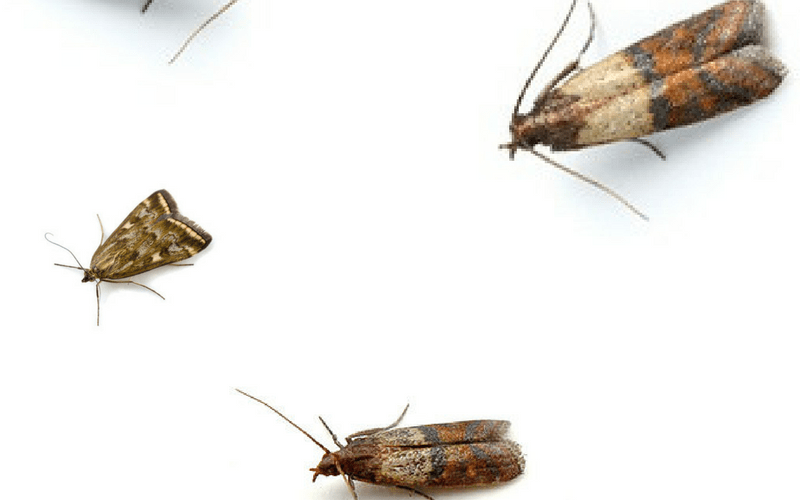There are several kinds of pantry moths, all under one inch in length and with drab grayish or brownish colors. When you see these small moths fluttering about, usually toward nightfall, look for where they are coming from. It is their larvae that cause the damage to our foodstuffs. These small cream to brownish caterpillars are found in stored foods worldwide. They usually get into our homes in a food package that has larvae or eggs already inside.
Locate the larvae by looking in opened packages of grains, flours, peas, rice, beans, pet food, spices, dried fruits and nuts, chocolate, cereals, sauce mixes, cookies, croutons, crackers and other grain products. Besides the larvae, speckles can be present along with silken webbings the caterpillars have spun. Even unopened containers need to be checked, since caterpillars can chew through plastic, shrink wrap, and cardboard or crawl under box flaps.
If you can find the infestation before it spreads, simply discard the food product or kill the larvae and eggs by freezing the foodstuff for 4 days. Then if you intend to use the food, sift out the larvae. If the infestation has spread, thorough cleaning is needed. Go through everything, taking contaminated items outside for disposal.
Since pantry moths lay eggs in tiny crevices and cracks, remove everything from storage areas and vacuum thoroughly. Take vacuum contents to the outside garbage. Then wash everything, including cans and other foodstuff containers, with plenty of hot soapy water or vinegar water or bleach solution so it penetrates all surfaces and cracks. When dry, caulk cracks to eliminate hiding places.
Check in areas nearby your storage area for coccons, including curtains and fabrics. Caterpillars can crawl some distance from their feeding place to pupate. A cocoon is enclosed in a web-like yellowish mesh of silk like a little dome glued down to a flat surface. Destroy these too.
To lessen the chance of reinfestation, take care when buying food in bulk. Nearly all bulk grain storage is already infested. Or if you do, freeze items as they come into your home to kill eggs and larvae and then store foods in air-tight containers such as glass jars with rubber gaskets. Many containers which seem air-tight are not. Check by filling with water and inverting. If it leaks, pantry moths can get into it. Even screw-lid jars are vulnerable. Some people report success with thick zip-lock bags.
Make a habit of checking your stored foodstuffs on a regular basis. You can also purchase pantry moth pheromone traps. These do not control infestations but will help you monitor for the presence of adult moths so that you can check food for new infestations. The traps have a chemical in them that attracts male moths. The traps need to be renewed about every 3 months and only one should be put out in a room.
If you plan to use pheromone traps, you sometimes need to know what kind of pantry moths you have to get the right kind of pheromone. Some of the commonest are the Indian meal moth, which is gray with a copper band across the forewings; the Mediterranean flour moth, gray with two black stripes down the top wing; and the Angoumis grain moth, which is buffy or grayish, with the hind wings tapering to a point and edged with a fringe of long hairs.
Sometimes people place dried bay leaves in cupboards or storage areas, several to a shelf as a preventative. Renew these regularly if you try this. With patience and hard work and surveillance, you can get rid of pantry moths.
<>





